Spatial and Temporal Evaluation of PM10 and PM2.5 in the Tropical Weather City Context: Effect of Environmental Parameters and Fixed-Pollution Sources
Abstract
1. Introduction
2. Materials and Methods
2.1. Location of Sampling Sites
2.2. Data Sources
2.3. Monitoring and Data Management
2.4. Fixed Pollution Source Identification
2.5. Data Analysis
3. Results
3.1. Temporal Analysis Results
3.2. Spatial Results
3.3. PM2.5/PM10 Ratio
4. Discussion
4.1. Temporal Analysis
4.2. Spatial Analysis
5. Conclusions
Author Contributions
Funding
Data Availability Statement
Acknowledgments
Conflicts of Interest
Abbreviations
| PM | Particulate matter |
| SDS | Secretary of Sustainable Development (SDS in Spanish) |
| SEDER | Secretary of Rural Development (SEDER in Spanish) |
| IYEM | Yucatecan Institute of Entrepreneurs (IYEM in Spanish) |
| OPC | Optical particle counters |
| AQI | Air quality index |
| MSD | Mean square displacement |
| PCA | Principal component analysis |
| AADT | Annual average daily traffic |
| HDDV | Heavy-duty diesel vehicles |
References
- Diario Oficial de la Federación. NOM-025-SSA1-2021: Salud Ambiental. Criterio para Evaluar la Calidad del Aire Ambiente, Con Respecto a las Partículas Suspendidas PM10 y PM2.5. Valores Normados para la Concentración de Partículas Suspendidas PM10 y PM2.5 en el Aire Ambiente, Como Medida de Protección a la Salud de la Población. DOF, 27 October 2021. Available online: https://www.dof.gob.mx/nota_detalle.php?codigo=5633855&fecha=27/10/2021#gsc.tab=0 (accessed on 15 November 2024).
- US EPA. Final Rule to Strengthen the National Air Quality Health Standard for Particulate Matter Standards. U.S. Environmental Protection Agency, 7 February 2024. Available online: https://www.epa.gov/system/files/documents/2024-02/pm-naaqs-overview.pdf (accessed on 10 October 2025).
- World Health Organization. WHO Global Air Quality Guidelines: Particulate Matter (PM2.5 and PM10), Ozone, Nitrogen Dioxide, Sulfur Dioxide and Carbon Monoxide. World Health Organization 2021. Available online: https://www.who.int/publications/i/item/9789240034228 (accessed on 10 October 2025).
- Kumar, V.; Sahu, M.; Biswal, B.; Prakash, J.; Choudhary, S.; Raliya, R.; Chadha, T.S.; Fang, J.; Biswas, P. Real-Time Source Apportionment of Particulate Matter from Low-Cost Particle Sensors Using Machine Learning. Aerosol Sci. Eng. 2024. [Google Scholar] [CrossRef]
- Bonilla-Granados, C.A.; Sánchez-Delgado, A.Y.; Rubio-Gómez, Y.M.; Cortez-Huerta, M. Niveles de concentración por PM2.5 mediante sensores de bajo costo. Caso de estudio: Pamplona, Colombia. Rev. UIS Ing. 2023, 22, 29–38. [Google Scholar] [CrossRef]
- Kramer, A.L.; Liu, J.; Li, L.; Connolly, R.; Barbato, M.; Zhu, Y. Environmental justice analysis of wildfire-related PM2.5 exposure using low-cost sensors in California. Sci. Total Environ. 2023, 856, 159218. [Google Scholar] [CrossRef]
- Song, B.; Park, K.; Kim, T.; Seo, G. Analysis of spatiotemporal PM2.5 concentration patterns in Changwon, Korea, using low-cost PM2.5 sensors. Urban Clim. 2022, 46, 101292. [Google Scholar] [CrossRef]
- McDuffie, E.E.; Martin, R.V.; Spadaro, J.V.; Burnett, R.; Smith, S.J.; O’Rourke, P.; Hammer, M.S.; Van Donkelaar, A.; Bindle, L.; Shah, V.; et al. Source sector and fuel contributions to ambient PM2.5 and attributable mortality across multiple spatial scales. Nat. Commun. 2021, 12, 3594. [Google Scholar] [CrossRef]
- Karagulian, F.; Belis, C.A.; Dora, C.F.C.; Prüss-Ustün, A.M.; Bonjour, S.; Adair-Rohani, H.; Amann, M. Contributions to cities’ ambient particulate matter (PM): A systematic review of local source contributions at global level. Atmos. Environ. 2015, 120, 475–483. [Google Scholar] [CrossRef]
- Li, Q.; Wang, Y.; Chen, W.; Li, M.; Fang, X. Does improvement of industrial land use efficiency reduce PM2.5 pollution? Evidence from a spatiotemporal analysis of China. Ecol. Indic. 2021, 132, 108333. [Google Scholar] [CrossRef]
- Gentner, D.R.; Jathar, S.H.; Gordon, T.D.; Bahreini, R.; Day, D.A.; Haddad, I.E.; Hayes, P.L.; Pieber, S.M.; Platt, S.M.; De Gouw, J.; et al. Review of Urban Secondary Organic Aerosol Formation from Gasoline and Diesel Motor Vehicle Emissions. Environ. Sci. Technol. 2017, 51, 1074–1093. [Google Scholar] [CrossRef]
- Mukherjee, A.; McCarthy, M.C.; Brown, S.G.; Huang, S.; Landsberg, K.; Eisinger, D.S. Influence of roadway emissions on near-road PM2.5: Monitoring data analysis and implications. Transp. Res. Part D Transp. Environ. 2020, 86, 102442. [Google Scholar] [CrossRef]
- Alshetty, D.; Nagendra, S.S. Impact of vehicular movement on road dust resuspension and spatiotemporal distribution of particulate matter during construction activities. Atmos. Pollut. Res. 2022, 13, 101256. [Google Scholar] [CrossRef]
- Wang, M.; Duan, Y.; Zhang, Z.; Huo, J.; Huang, Y.; Fu, Q.; Wang, T.; Cao, J.; Lee, S. Increased Contribution to PM2.5 from Traffic-Influenced Road Dust in Shanghai over Recent Years and Predictable Future. Environ. Pollut. 2022, 313, 120119. [Google Scholar] [CrossRef] [PubMed]
- Secretary of Economy. Mérida: Economía, Empleo, Equidad, Calidad de Vida, Educación, Salud y Seguridad Pública|Data México. 2024. Available online: https://www.economia.gob.mx/datamexico/es/profile/geo/merida?redirect=true (accessed on 10 January 2025).
- INEGI. Parque Vehicular. 2024. Available online: https://www.inegi.org.mx/temas/vehiculos/#tabulados (accessed on 3 October 2024).
- Karanasiou, A.; Moreno, N.; Moreno, T.; Viana, M.; De Leeuw, F.; Querol, X. Health Effects from Sahara Dust Episodes in Europe: Literature Review and Research Gaps. Environ. Int. 2012, 47, 107–114. [Google Scholar] [CrossRef]
- Varrica, D.; Alaimo, M.G. Influence of Saharan Dust on the Composition of Urban Aerosols in Palermo City (Italy). Atmosphere 2024, 15, 254. [Google Scholar] [CrossRef]
- NASA. Godzilla Dust Storm. NASA’s Scientific Visualization Studio, 19 April 2021. Available online: https://svs.gsfc.nasa.gov/4849 (accessed on 5 September 2024).
- Remoundaki, E.; Papayannis, A.; Kassomenos, P.; Mantas, E.; Kokkalis, P.; Tsezos, M. Influence of Saharan Dust Transport Events on PM2.5 Concentrations and Composition over Athens. Water Air Soil Pollut. 2012, 224, 1373. [Google Scholar] [CrossRef]
- Raga, G.B.; Ladino, L.A.; Baumgardner, D.; Ramírez-Romero, C.; Córdoba, F.; Álvarez-Ospina, H.; Rosas, D.; Amador, T.; Miranda, J.; Rosas, I.; et al. ADABBOY: African Dust and Biomass Burning over Yucatan. Bull. Am. Meteorol. Soc. 2021, 102, 1543–1556. [Google Scholar] [CrossRef]
- Yu, H.; Tan, Q.; Zhou, L.; Zhou, Y.; Bian, H.; Chin, M.; Ryder, C.L.; Levy, R.C.; Pradhan, Y.; Shi, Y.; et al. Observation and Modeling of a Historic African Dust Intrusion into the Caribbean Basin and the Southern U.S. in June 2020. Atmos. Chem. Phys. 2021, 21, 12359–12383. [Google Scholar] [CrossRef]
- Amil, N.; Latif, M.T.; Khan, M.F.; Mohamad, M. Seasonal Variability of PM2.5 Composition and Sources in the Klang Valley Urban-Industrial Environment. Atmos. Chem. Phys. 2016, 16, 5357–5381. [Google Scholar] [CrossRef]
- Requia, W.J.; Jhun, I.; Coull, B.A.; Koutrakis, P. Climate Impact on Ambient PM2.5 Elemental Concentration in the United States: A Trend Analysis over the Last 30 Years. Environ. Int. 2019, 131, 104888. [Google Scholar] [CrossRef]
- Wang, R.; Cui, K.; Sheu, H.; Wang, L.; Liu, X. Effects of Precipitation on the Air Quality Index, PM2.5 Levels and on the Dry Deposition of PCDD/Fs in the Ambient Air. Aerosol Air Qual. Res. 2023, 23, 220417. [Google Scholar] [CrossRef]
- Song, Z.; Wang, M.; Yang, H. Quantification of the Impact of Fine Particulate Matter on Solar Energy Resources and Energy Performance of Different Photovoltaic Technologies. ACS Environ. Au 2022, 2, 275–286. [Google Scholar] [CrossRef]
- Liu, Z.; Shen, L.; Yan, C.; Du, J.; Li, Y.; Zhao, H. Analysis of the Influence of Precipitation and Wind on PM2.5 and PM10 in the Atmosphere. Adv. Meteorol. 2020, 2020, 5039613. [Google Scholar] [CrossRef]
- Zhang, X.; Xu, H.; Liang, D. Spatiotemporal Variations and Connections of Single and Multiple Meteorological Factors on PM2.5 Concentrations in Xi’an, China. Atmos. Environ. 2022, 275, 119015. [Google Scholar] [CrossRef]
- Instituto de Ciencias de la Atmósfera y Cambio Climático. Episodios de Muy Alta Contaminación con Contingencias Ambientales en la Megalópolis y Lecciones por Aprender. 2024. Available online: https://www.gob.mx/cms/uploads/attachment/file/1009971/39._Episodios_muy_alta_contaminacion_con_contingencias_ambientales_Megalopolis.pdf (accessed on 15 January 2025).
- Pan, L.; Xu, J.; Tie, X.; Mao, X.; Gao, W.; Chang, L. Long-Term Measurements of Planetary Boundary Layer Height and Interactions with PM2.5 in Shanghai, China. Atmos. Pollut. Res. 2019, 10, 989–996. [Google Scholar] [CrossRef]
- Orellana, R.; Espadas Manrique, C.; Nava, F. Climas. In Biodiversidad y Desarrollo Humano en Yucatán; Duran, R., Méndez, M., Eds.; CICY: Mérida, Mexico, 2010; pp. 10–11. [Google Scholar]
- Thermo Fisher Scientific Inc. Thermo Scientific Model 42i NO-NO2-NOx Chemiluminescent Gas Analyzer. 2024. Available online: https://documents.thermofisher.com/TFS-Assets/LSG/Specification-Sheets/EPM-42i-Datasheet.pdf (accessed on 10 December 2024).
- Thermo Fisher Scientific Inc. Thermo Scientific Model 43i Sulfur Dioxide Analyzer. 2024. Available online: https://documents.thermofisher.com/TFS-Assets/LSG/Specification-Sheets/EPM-43i-Datasheet.pdf (accessed on 10 December 2024).
- Thermo Fisher Scientific Inc. Thermo Scientific Model 48i Carbon Monoxide Analyzer. 2024. Available online: https://documents.thermofisher.com/TFS-Assets/LSG/Specification-Sheets/EPM-48i-Datasheet.pdf (accessed on 10 December 2024).
- Thermo Fisher Scientific Inc. Thermo Scientific Model 49i UV Photometric Ozone Analyzer. 2024. Available online: https://documents.thermofisher.com/TFS-Assets/CAD/Specification-Sheets/EPM-49i-Datasheet.pdf (accessed on 10 December 2024).
- Thermo Fisher Scientific Inc. Model 5014i Beta Continuous Particulate Monitor. 2025. Available online: https://documents.thermofisher.com/TFS-Assets/CAD/Specification-Sheets/D00882.pdf (accessed on 12 January 2025).
- U.S. EPA. Technical Assistance Document (TAD) for the Reporting of Daily Air Quality—The Air Quality Index (AQI); U.S. Environmental Protection Agency, Office of Air Quality Planning and Standards: Durham, NC, USA, 2018; EPA 454/B-18-007.
- PurpleAir. How Is Particulate Matter (PM) Measured? 2024. Available online: https://www2.purpleair.com/blogs/blog-home/how-is-pm-measured?#Which (accessed on 15 January 2025).
- California Air Resources Board. Outline of Measurement Technologies. Available online: https://ww2.arb.ca.gov/capp-resource-center/community-air-monitoring/outline-of-measurement-technologies#part:~:text=time%20sensitive%20applications.-,Particle%20Counting,-Particles%20in%20air (accessed on 15 January 2025).
- PurpleAir Community Q: Can I Calibrate My PurpleAir sensor? Available online: https://community.purpleair.com/t/q-can-i-calibrate-my-purpleair-sensor/844/1 (accessed on 22 June 2022).
- National Institute of Ecology. Handbook 5: Air Quality Data Management Protocol. 2010. Available online: https://sinaica.inecc.gob.mx/archivo/guias/5%20-%20Protocolo%20de%20Manejo%20de%20Datos%20de%20la%20Calidad%20del%20Aire.pdf (accessed on 15 September 2024).
- Tian, P.; Zhang, L.; Ma, J.; Tang, K.; Xu, L.; Wang, Y.; Cao, X.; Liang, J.; Ji, Y.; Jiang, J.H.; et al. Radiative Absorption Enhancement of Dust Mixed with Anthropogenic Pollution over East Asia. Atmos. Chem. Phys. 2018, 18, 7815–7825. [Google Scholar] [CrossRef]
- Drăgoi, L.; Cazacu, M.-M.; Breabăn, I.-G. Analysis of the PM2.5/PM10 Ratio in Three Urban Areas of Northeastern Romania. Atmosphere 2025, 16, 720. [Google Scholar] [CrossRef]
- Fan, H.; Zhao, C.; Yang, Y.; Yang, X. Spatio-Temporal Variations of the PM2.5/PM10 Ratios and Its Application to Air Pollution Type Classification in China. Front. Environ. Sci. 2021, 9, 692440. [Google Scholar] [CrossRef]
- Xu, G.; Jiao, L.; Zhang, B.; Zhao, S.; Yuan, M.; Gu, Y.; Liu, J.; Tang, X. Spatial and Temporal Variability of the PM2.5/PM10 Ratio in Wuhan, Central China. Aerosol Air Qual. Res. 2017, 17, 741–751. [Google Scholar] [CrossRef]
- Choudhary, A.; Kumar, P.; Sahu, S.K.; Pradhan, C.; Joshi, P.K.; Singh, S.K.; Kumar, P.; Mezoue, C.A.; Singh, A.K.; Tyagi, B. Health Risk Appraisal Associated with Air Quality over Coal-Fired Thermal Power Plants and Coalmine Complex Belts of Urban–Rural Agglomeration in the Eastern Coastal State of Odisha, India. Atmosphere 2022, 13, 2064. [Google Scholar] [CrossRef]
- CONAGUA. Monthly Rainfall and Temperature Summaries. 2024. Available online: https://smn.conagua.gob.mx/es/climatologia/temperaturas-y-lluvias/resumenes-mensuales-de-temperaturas-y-lluvias (accessed on 10 January 2025).
- Bracho, R.; Flores-Espino, F.; Morgenstein, J.; Aznar, A.; Castillo, R.; Settle, E. Evaluación Energética de la Península de Yucatán: Vías para un Sistema Energético Limpio y Sustentable; Laboratorio Nacional de Energía Renovable: Golden, CO, USA, 2021; NREL/TP-7A40-81142. Available online: https://www.nrel.gov/docs/fy21osti/81142.pdf (accessed on 10 January 2025).
- Diksha, N.; Kumari, M.; Mishra, V.N.; Kumar, D.; Kumar, P.; Abdo, H.G. Unveiling Pollutants in Sonipat District, Haryana: Exploring Seasonal, Spatial and Meteorological Patterns. Phys. Chem. Earth 2024, 135, 103678. [Google Scholar] [CrossRef]
- Wang, L.; Qin, K.; Zhao, B. Spatiotemporal Variations in the Association between PM2.5 and Ozone in the Yangtze River Economic Belt: Impacts of Meteorological and Emissions Factors. Atmos. Environ. 2024, 329, 120534. [Google Scholar] [CrossRef]
- Kumar, P.; Pratap, V.; Kumar, A.; Choudhary, A.; Prasad, R.; Shukla, A.; Singh, R.; Singh, A.K. Assessment of Atmospheric Aerosols over Varanasi: Physical, Optical and Chemical Properties and Meteorological Implications. J. Atmos. Sol.-Terr. Phys. 2020, 209, 105424. [Google Scholar] [CrossRef]
- Wang, J.; Ogawa, S. Effects of Meteorological Conditions on PM2.5 Concentrations in Nagasaki, Japan. Int. J. Environ. Res. Public Health 2015, 12, 9089–9101. [Google Scholar] [CrossRef] [PubMed]
- Gupta, A.K.; Nag, S.; Mukhopadhyay, U.K. Characterisation of PM10, PM2.5 and Benzene Soluble Organic Fraction of Particulate Matter in an Urban Area of Kolkata, India. Environ. Monit. Assess. 2006, 115, 205–222. [Google Scholar] [CrossRef]
- Feng, X.; Wang, S. Influence of Different Weather Events on Concentrations of Particulate Matter with Different Sizes in Lanzhou, China. J. Environ. Sci. 2012, 24, 665–674. [Google Scholar] [CrossRef]
- Zhou, X.; Cao, Z.; Ma, Y.; Wang, L.; Wu, R.; Wang, W. Concentrations, Correlations and Chemical Species of PM2.5/PM10 Based on Published Data in China: Potential Implications for the Revised Particulate Standard. Chemosphere 2015, 144, 518–526. [Google Scholar] [CrossRef] [PubMed]
- Zha, H.; Wang, R.; Feng, X.; An, C.; Qian, J. Spatial Characteristics of the PM2.5/PM10 Ratio and Its Indicative Significance Regarding Air Pollution in Hebei Province, China. Environ. Monit. Assess. 2021, 193, 92. [Google Scholar] [CrossRef] [PubMed]
- Chu, H.; Huang, B.; Lin, C. Modeling the Spatio-Temporal Heterogeneity in the PM10–PM2.5 Relationship. Atmos. Environ. 2014, 102, 176–182. [Google Scholar] [CrossRef]
- Bamola, S.; Goswami, G.; Dewan, S.; Goyal, I.; Agarwal, M.; Dhir, A.; Lakhani, A. Characterising Temporal Variability of PM2.5/PM10 Ratio and Its Correlation with Meteorological Variables at a Sub-Urban Site in the Taj City. Urban Clim. 2023, 53, 101763. [Google Scholar] [CrossRef]
- Spandana, B.; Rao, S.S.; Upadhya, A.R.; Kulkarni, P.; Sreekanth, V. PM2.5/PM10 Ratio Characteristics over Urban Sites of India. Adv. Space Res. 2021, 67, 3134–3146. [Google Scholar] [CrossRef]
- SDS. SDS Monitoring Station Report June 23–25 2020; Yucatán State Government: Mérida, México, 2020.
- Cortez-Huerta, M.; Echeverría, R.S.; García, G.F.; Durán, R.A.; Álvarez, P.S.; Magaña, V.; Retama, A. Influence of Particulate Matter on Air Quality Due to “Nortes” Events in the Gulf of Mexico. Atmos. Pollut. Res. 2023, 14, 101889. [Google Scholar] [CrossRef]
- Kabiraj, S.; Gavli, N. Impact of SARS-CoV-2 Pandemic Lockdown on Air Quality Using Satellite Imagery with Ground Station Monitoring Data in Most Polluted City Kolkata, India. Aerosol Sci. Eng. 2020, 4, 320–330. [Google Scholar] [CrossRef]
- Aladag, E. The Nexus between Air Pollution and the COVID-19 Pandemic in Turkey: Further Insights from Wavelet Coherence Analysis. Aerosol Sci. Eng. 2024, 8, 108–119. [Google Scholar] [CrossRef]
- Lara, R.; Megido, L.; Suárez-Peña, B.; Negral, L.; Fernández-Nava, Y.; Rodríguez-Iglesias, J.; Marañón, E.; Castrillón, L. Impact of COVID-19 Restrictions on Hourly Levels of PM10, PM2.5 and Black Carbon at an Industrial Suburban Site in Northern Spain. Atmos. Environ. 2023, 304, 119781. [Google Scholar] [CrossRef] [PubMed]
- Jin, Q.; Luo, Y.; Meng, X.; Feng, M.; Huang, C. Short- and Long-Term Impacts of the COVID-19 Epidemic on Urban PM2.5 Variations: Evidence from a Megacity, Chengdu. Atmos. Environ. 2022, 294, 119479. [Google Scholar] [CrossRef] [PubMed]
- Al-Hemoud, A.; Al-Khayat, A.; Al-Dashti, H.; Li, J.; Alahmad, B.; Koutrakis, P. PM2.5 and PM10 during COVID-19 Lockdown in Kuwait: Mixed Effect of Dust and Meteorological Covariates. Environ. Chall. 2021, 5, 100215. [Google Scholar] [CrossRef]
- CONAGUA. Reseña de la Tormenta Tropical “Cristóbal” del Océano Atlántico (1 al 10 de Junio de 2020). 2020. Available online: https://smn.conagua.gob.mx/tools/DATA/Ciclones%20Tropicales/Ciclones/2020-Cristobal%20.pdf (accessed on 10 January 2025).
- Belenio, L.; Colegial, J.; Barrera, M. Correlación entre el Flujo Vehicular, el PM2.5 y Variables Meteorológicas, un Estudio de Caso al Oriente de Bucaramanga (Colombia). BISTUA Rev. Fac. Cienc. Básicas 2020, 18, 15–25. [Google Scholar]
- Cheng, Z.; Li, L.; Liu, J. Identifying the Spatial Effects and Driving Factors of Urban PM2.5 Pollution in China. Ecol. Indic. 2017, 82, 61–75. [Google Scholar] [CrossRef]
- Domínguez, D. Merida Roads Are Saturated. Yucatan News Paper, 12 February 2024. Available online: https://www.yucatan.com.mx/merida/2024/02/12/vialidades-de-merida-saturadas.html (accessed on 10 January 2025).
- Cortes-Telles, A.; Ortiz-Farías, D.L.; Pou-Aguilar, Y.N.; Almeida-de-la-Cruz, L.; Perez-Padilla, J.R. Clinical Impact of Obesity on Respiratory Diseases: A Real-Life Study. Lung India 2021, 38, 321–325. [Google Scholar] [CrossRef] [PubMed]
- Mancilla-Hernández, E.; Barnica, R.; González-Solórzano, E.; Peregrina, J.A.; Zecua-Nájera, Y.; Soberanes-Rivas, G.A.; Jiménez-Sandoval, J.O. Prevalencia de Rinitis Alérgica y Factores Asociados en Estudiantes Mexicanos. Un Estudio Multicéntrico. Rev. Alerg. Méx. 2021, 68, 101–111. [Google Scholar] [CrossRef]

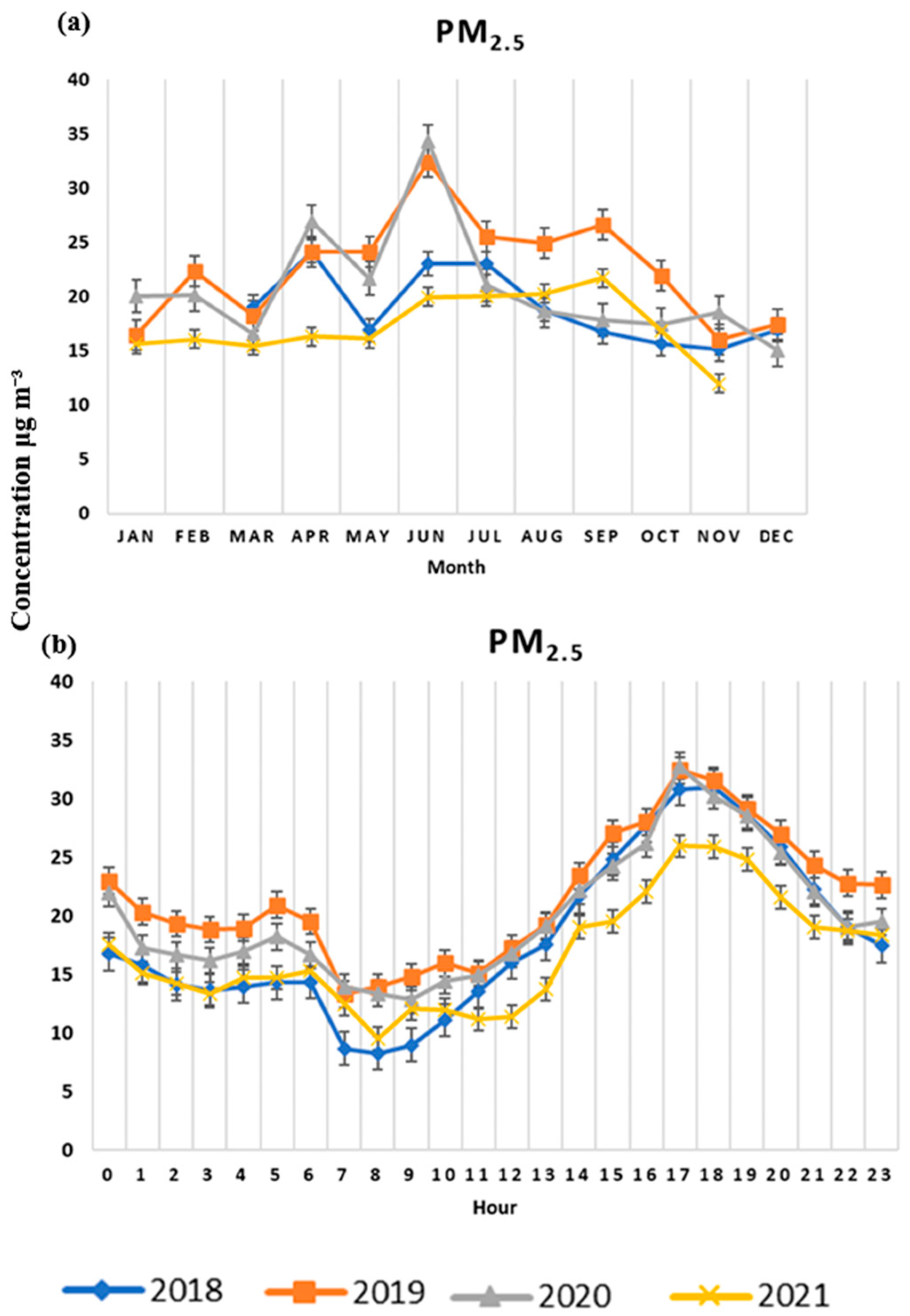
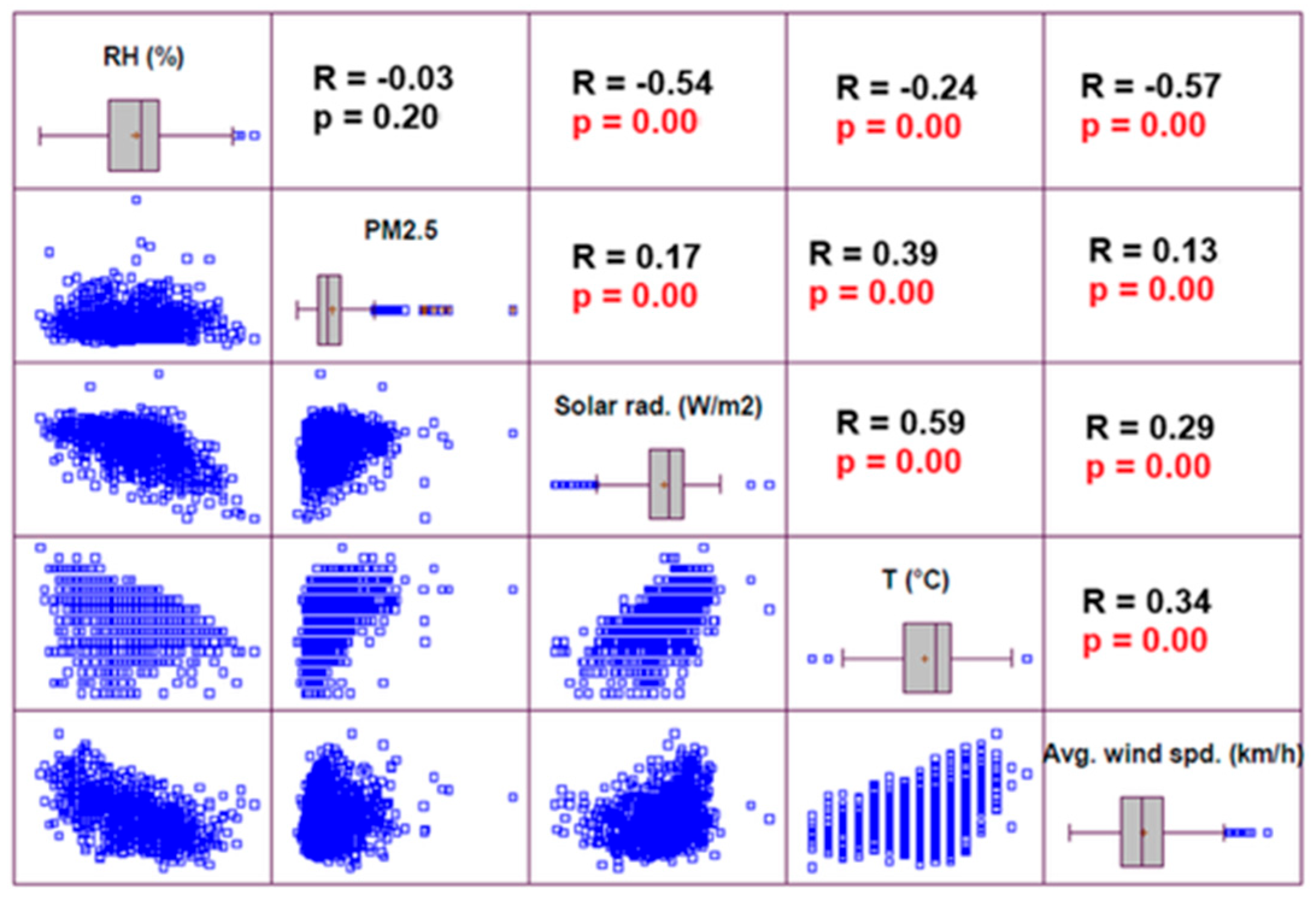
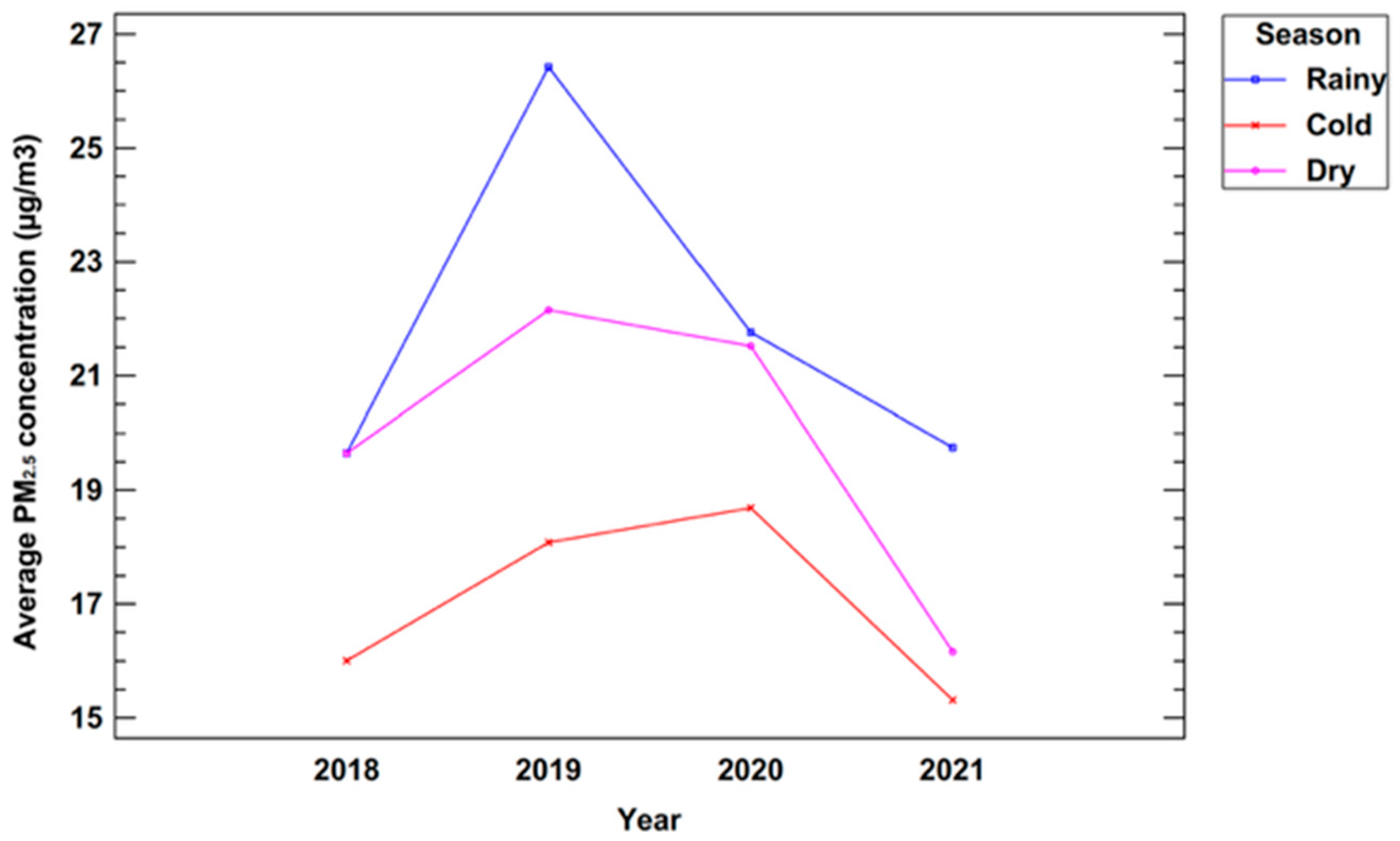
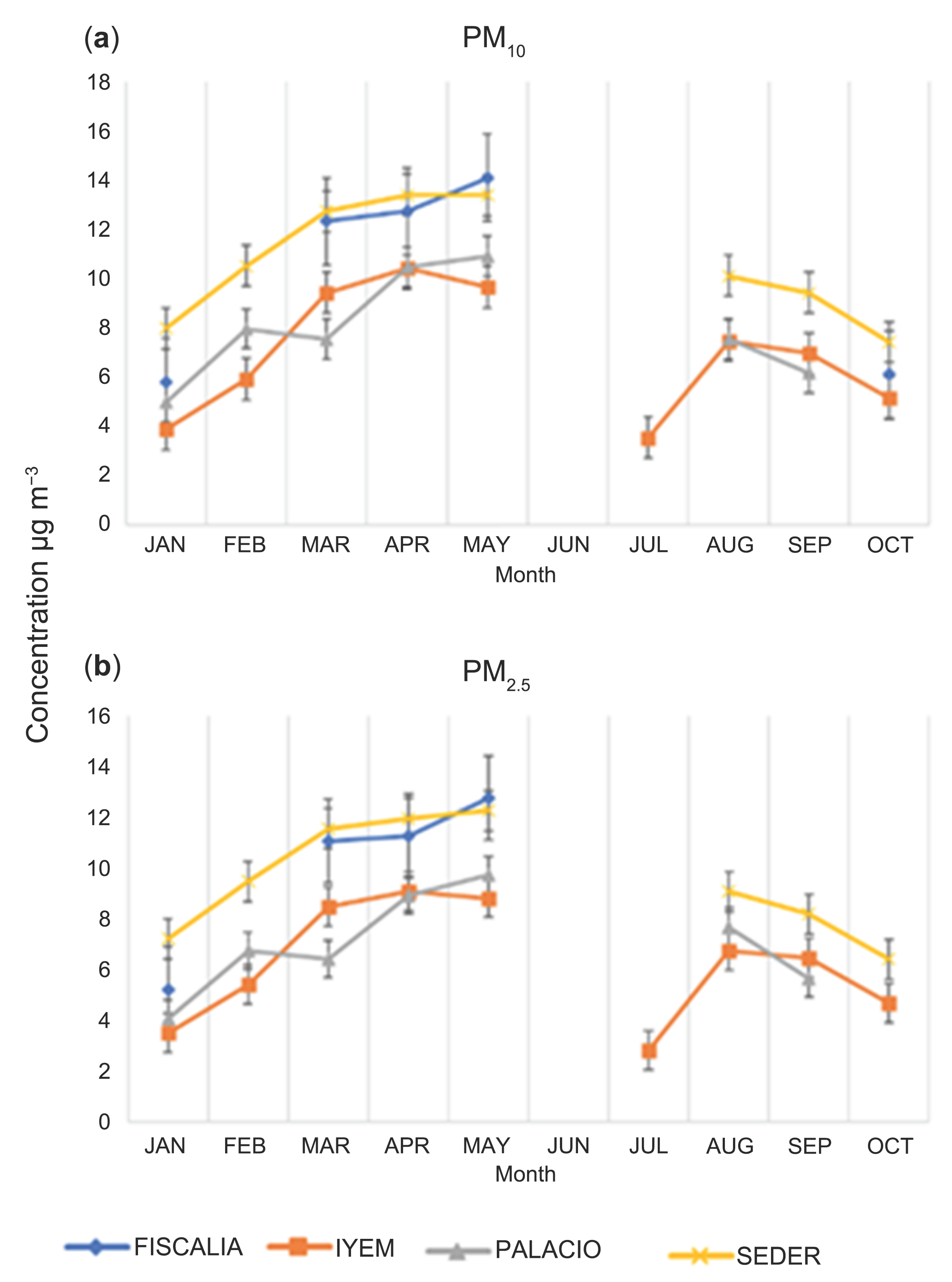

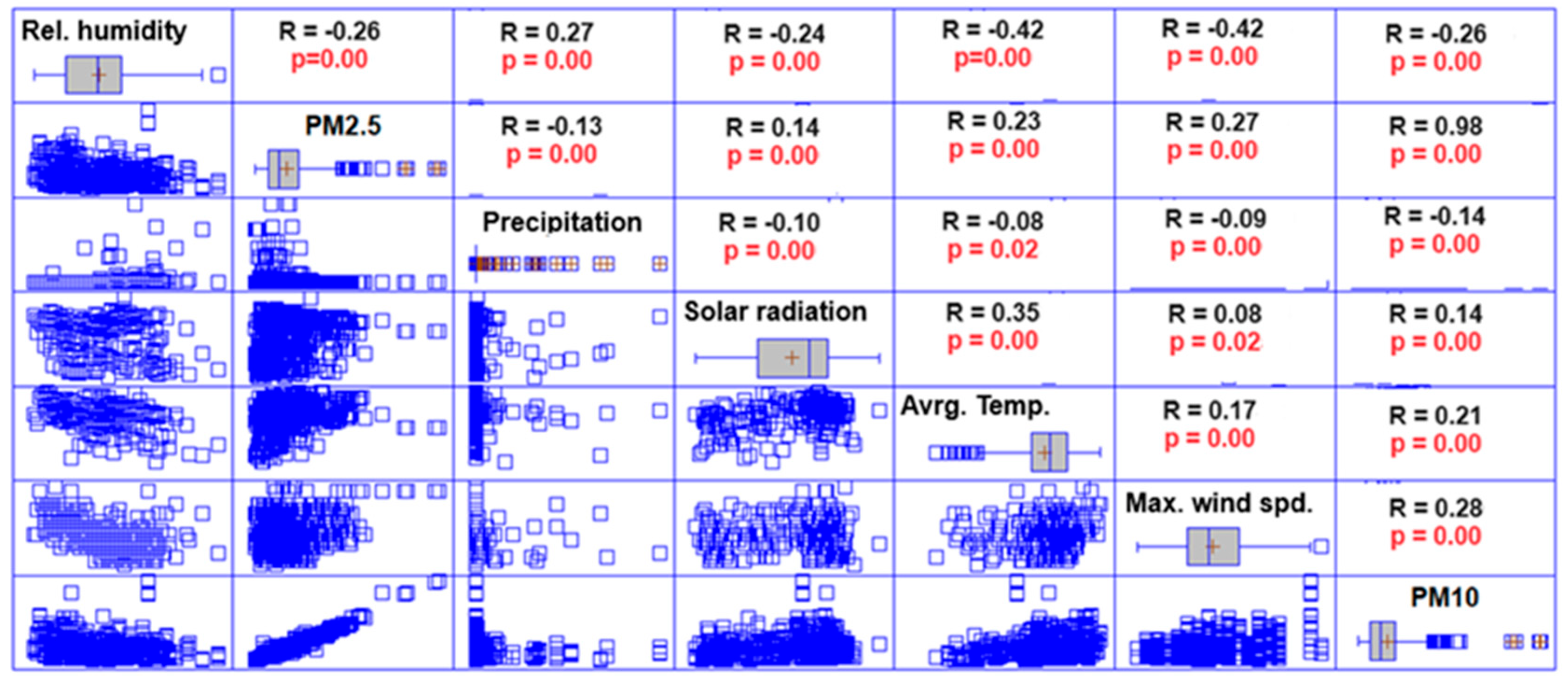
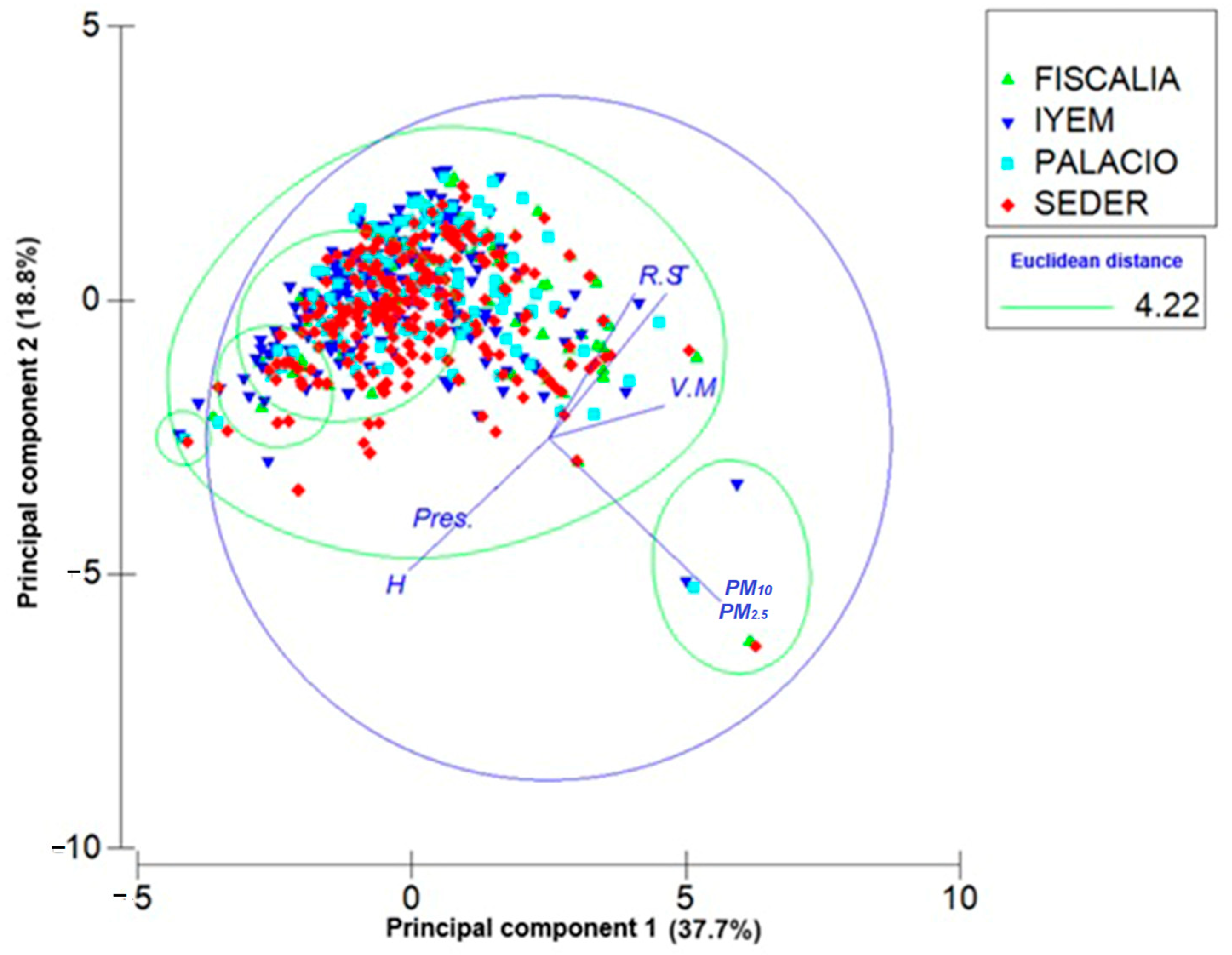
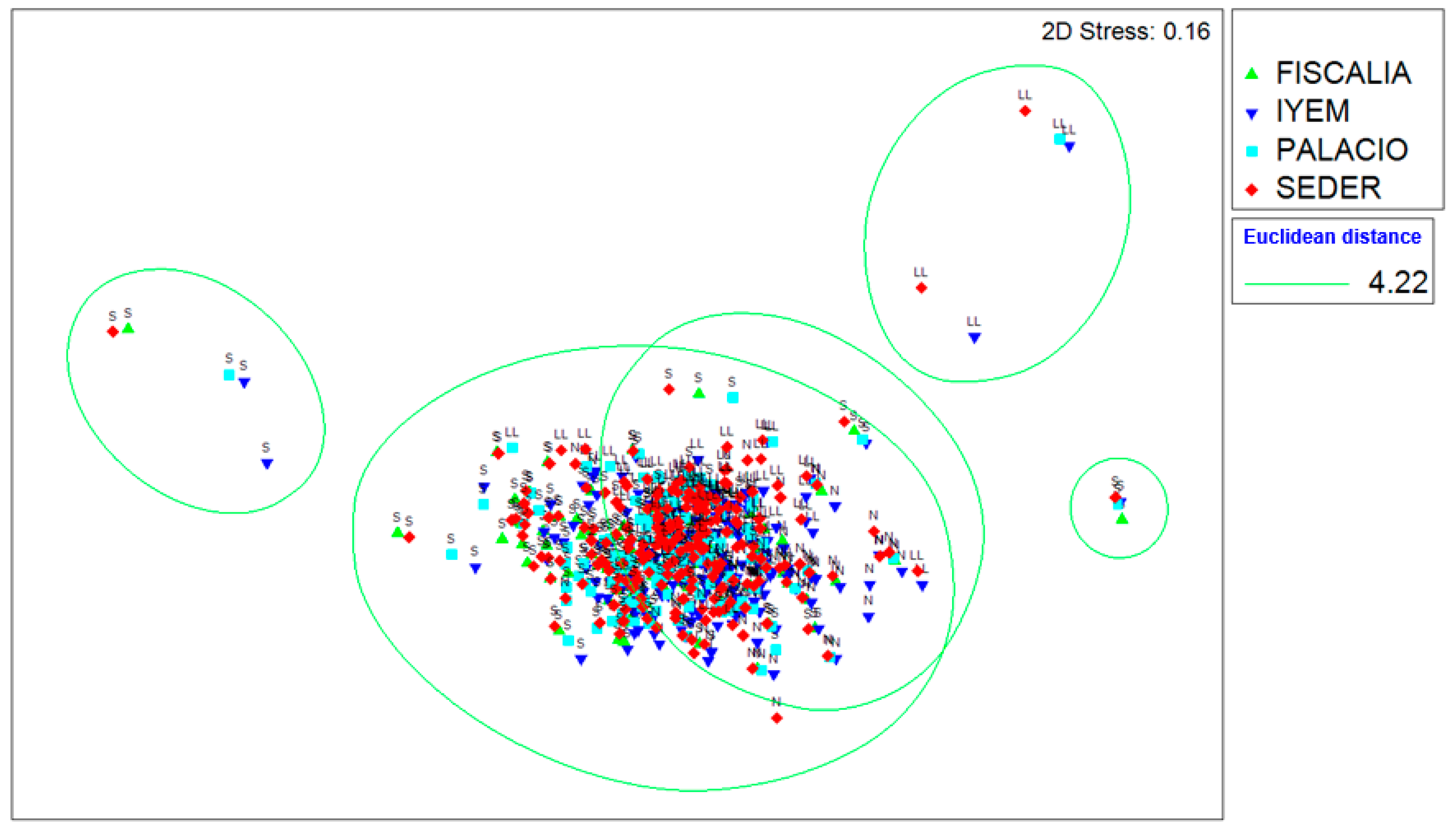
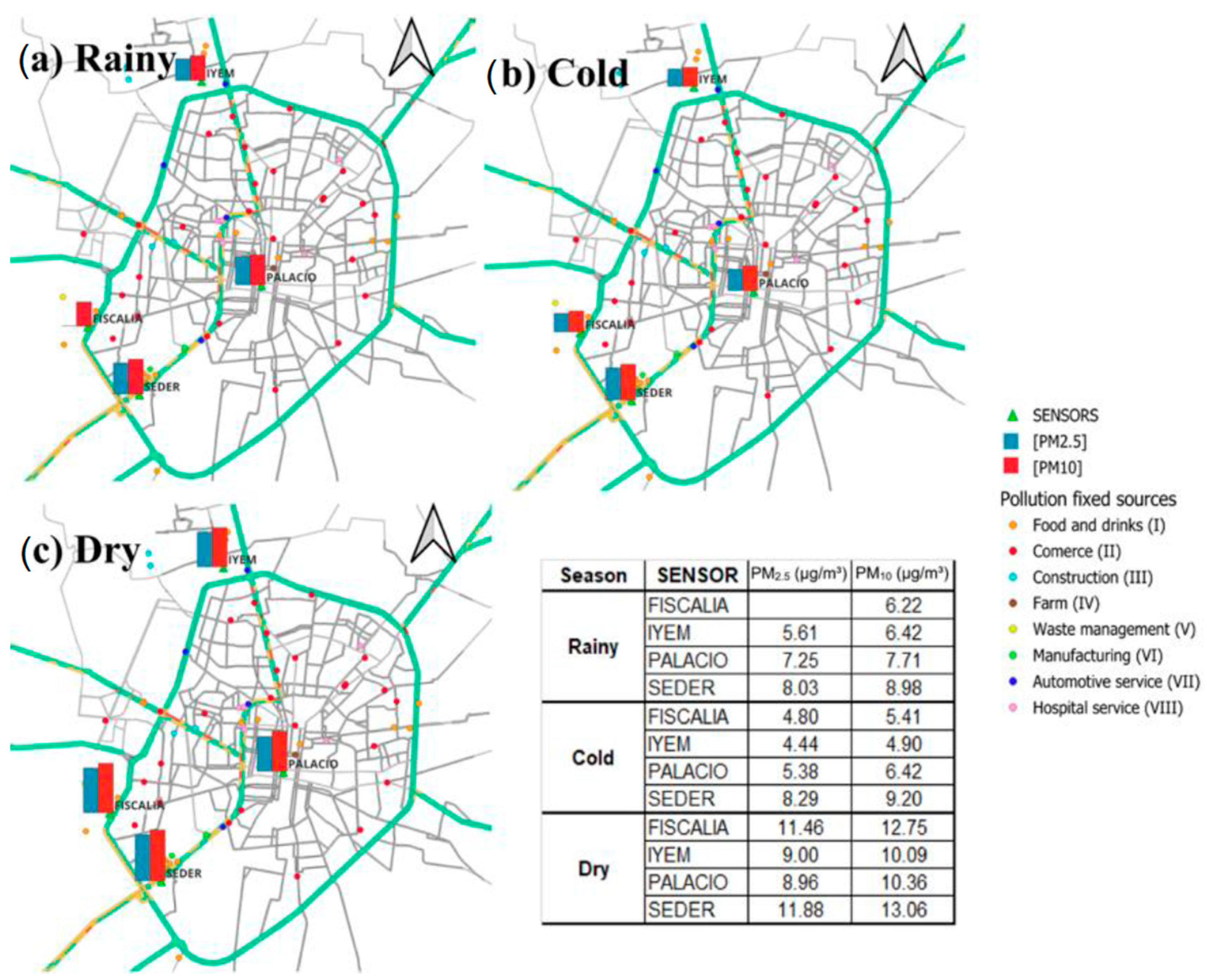

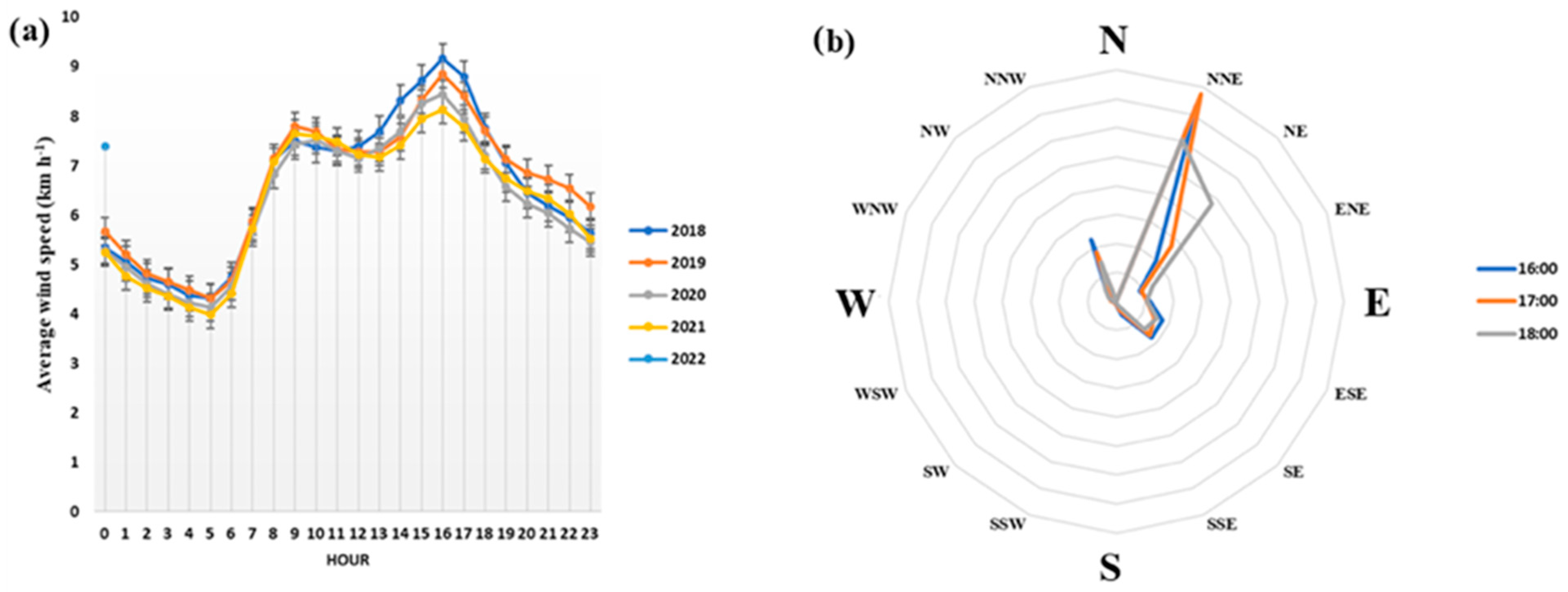
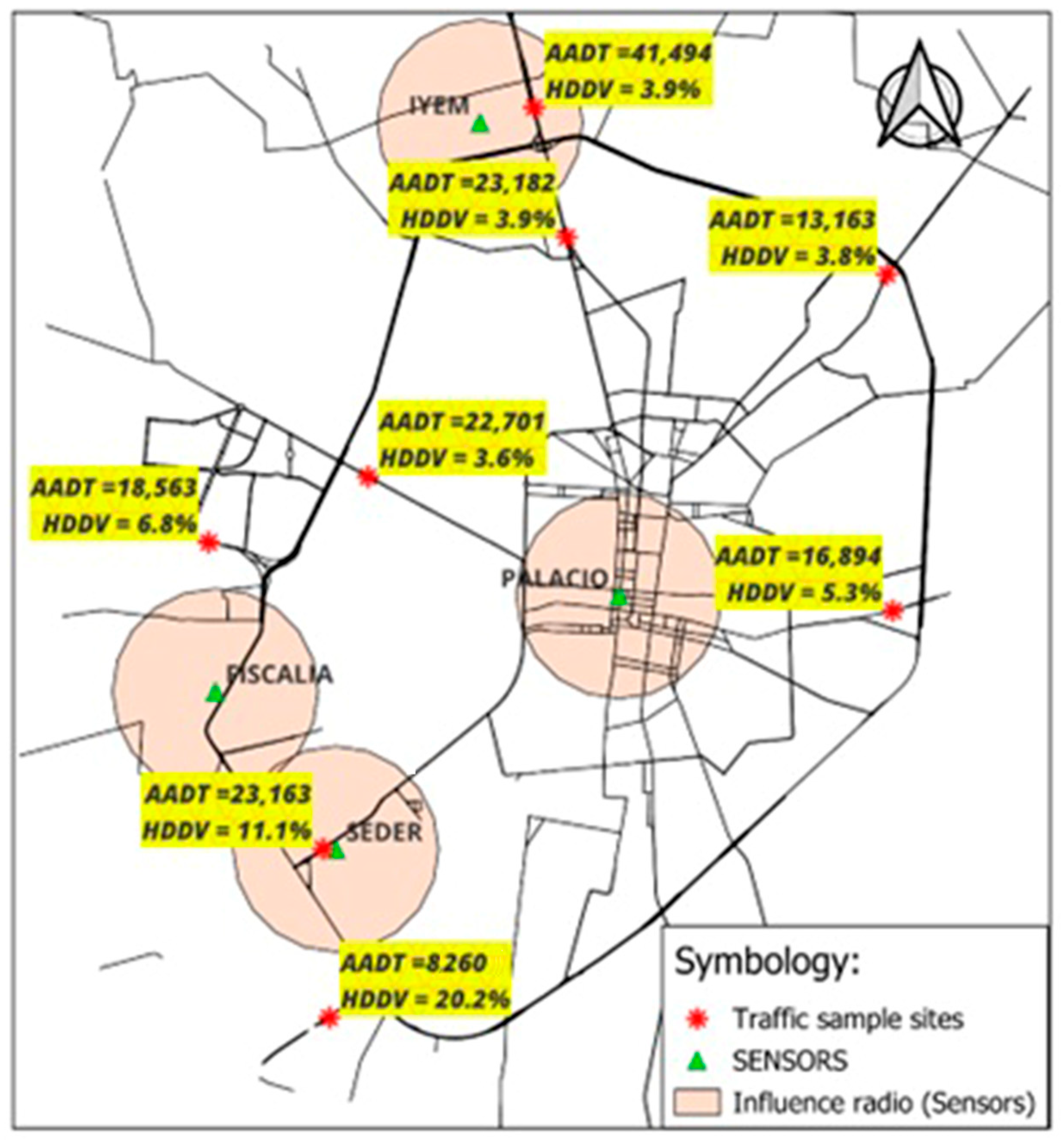
| Sensor ID | Location | Coordinates (Decimal Degrees) | Land Use |
|---|---|---|---|
| PALACIO | Government palace | 20.9676, −89.6232 | Downtown historic monuments zone |
| SEDER | Secretary of Rural Development | 20.9276, −89.6799 | Industrial zone |
| FISCALIA | Attorney General’s Office of the State of Yucatán | 20.9581, −89.6991 | Urban development |
| IYEM | Yucatecan Institute of Entrepreneurs | 21.0529, −89.6400 | Urban development |
| Pollutant | Concentration (μg m−3) | Monitoring Time |
|---|---|---|
| PM2.5 | 41 | 24 h |
| 10 | Annual |
| Pollutant | Concentration Limit/ Monitoring Time | 2018 | 2019 | 2020 | 2021 |
|---|---|---|---|---|---|
| PM2.5 | 41 μg m−3 (24 h) | 39 | 60 | 90 | 44 |
| 10 μg m−3 (Annual) | 19 | 23 | 21 | 18 |
| Factor | PM2.5 | PM10 |
|---|---|---|
| Season | H = 54.57 p-value = 1.40 × 10−12 | H = 55.95 p-value = 0 |
| Wind direction | H = 63.12 p-value = 3.29 × 10−8 | H = 60.44 p-value = 9.81 × 10−8 |
| Fixed pollution sources in the radius of influence | H = 55.87 p-value = 4.45 × 10−12 | H = 56.94 p-value = 2.63 × 10−12 |
| Relative humidity | H = 30.44 p-value = 3.42 × 10−8 | H = 31.48 p-value = 2.01 × 10−8 |
| Sensor location | H = 55.87 p-value = 4.45 × 10−12 | H = 56.94 p-value = 2.63 × 10−12 |
| Temperature | H = 23.44 p-value = 1.28 × 10−6 | H = 16.90 p-value = 3.92 × 10−5 |
| Precipitation | H = 16.49 p-value = 4.86 × 10−5 | H = 16.90 p-value = 3.92 × 10−5 |
Disclaimer/Publisher’s Note: The statements, opinions and data contained in all publications are solely those of the individual author(s) and contributor(s) and not of MDPI and/or the editor(s). MDPI and/or the editor(s) disclaim responsibility for any injury to people or property resulting from any ideas, methods, instructions or products referred to in the content. |
© 2025 by the authors. Licensee MDPI, Basel, Switzerland. This article is an open access article distributed under the terms and conditions of the Creative Commons Attribution (CC BY) license (https://creativecommons.org/licenses/by/4.0/).
Share and Cite
Quintal-Franco, C.A.; Mendicuti-Ramos, A.; Ponce-Caballero, C.; Góngora-Echeverría, V.R.; Aguilar-Escalante, S. Spatial and Temporal Evaluation of PM10 and PM2.5 in the Tropical Weather City Context: Effect of Environmental Parameters and Fixed-Pollution Sources. Earth 2025, 6, 133. https://doi.org/10.3390/earth6040133
Quintal-Franco CA, Mendicuti-Ramos A, Ponce-Caballero C, Góngora-Echeverría VR, Aguilar-Escalante S. Spatial and Temporal Evaluation of PM10 and PM2.5 in the Tropical Weather City Context: Effect of Environmental Parameters and Fixed-Pollution Sources. Earth. 2025; 6(4):133. https://doi.org/10.3390/earth6040133
Chicago/Turabian StyleQuintal-Franco, Carlos Alberto, Agur Mendicuti-Ramos, Carmen Ponce-Caballero, Virgilio René Góngora-Echeverría, and Sergio Aguilar-Escalante. 2025. "Spatial and Temporal Evaluation of PM10 and PM2.5 in the Tropical Weather City Context: Effect of Environmental Parameters and Fixed-Pollution Sources" Earth 6, no. 4: 133. https://doi.org/10.3390/earth6040133
APA StyleQuintal-Franco, C. A., Mendicuti-Ramos, A., Ponce-Caballero, C., Góngora-Echeverría, V. R., & Aguilar-Escalante, S. (2025). Spatial and Temporal Evaluation of PM10 and PM2.5 in the Tropical Weather City Context: Effect of Environmental Parameters and Fixed-Pollution Sources. Earth, 6(4), 133. https://doi.org/10.3390/earth6040133







